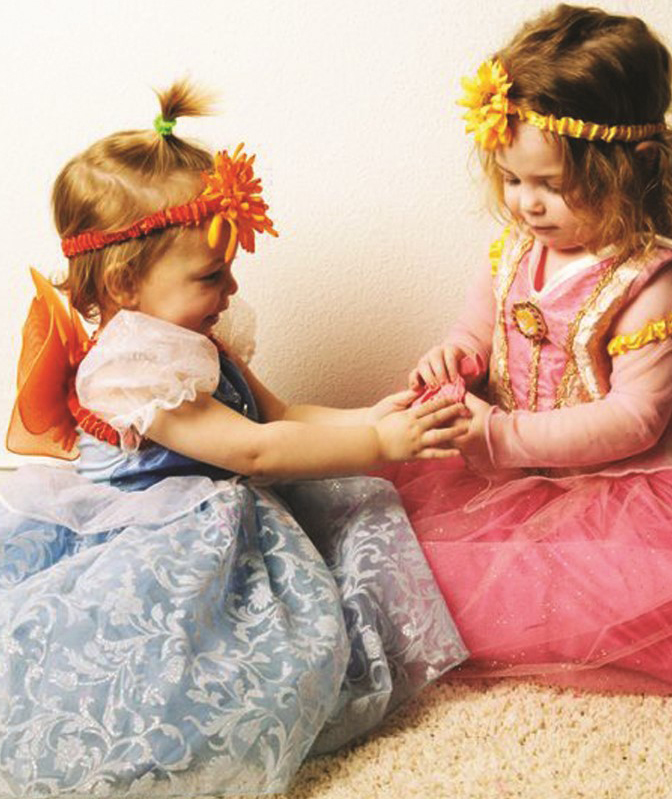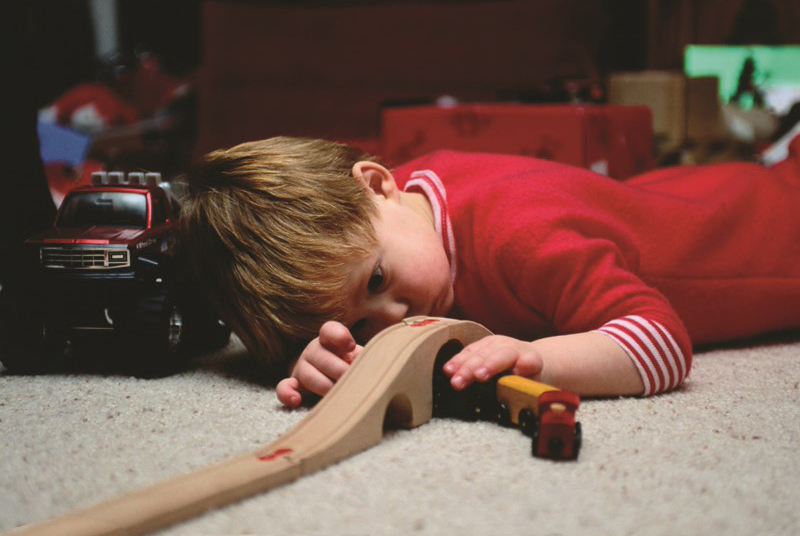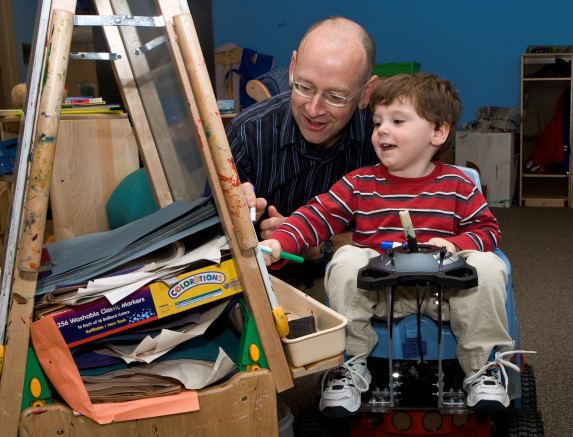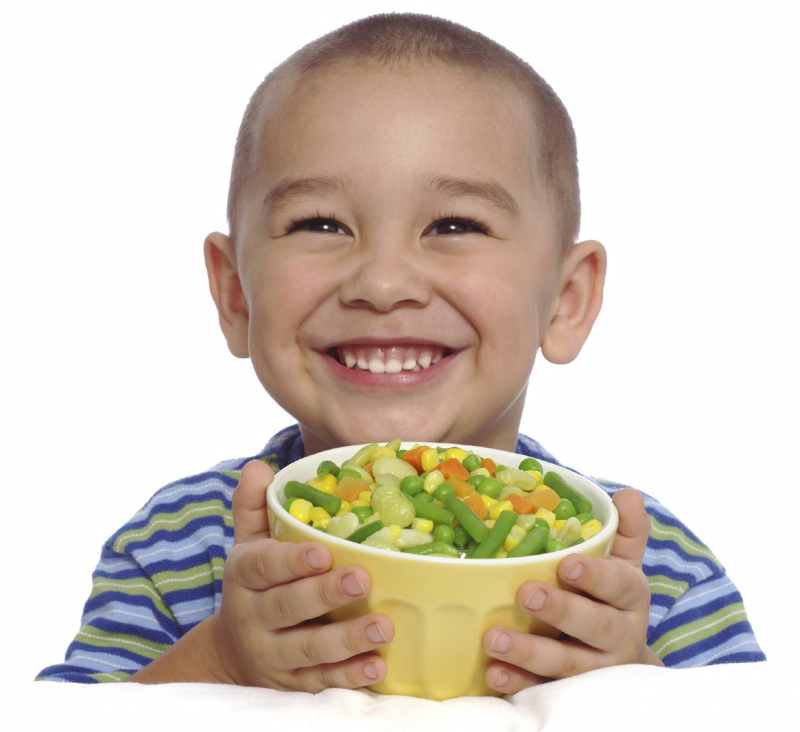2nd Year
MONTHS
21-22
2nd Year – Months 21-22
Play Is the Center of Your Toddler’s World

Poking, touching, and pushing are your child’s ways of showing interest in other children. They may be interested in a special friend their own age if that friend is with them a lot. You will notice your child will smile more and fight less with this friend than with a child who is a stranger.
From 2 to 3 years of age, your child will become more social and will enjoy playing with other children. Groups of children play best when they have the same toys or materials. They will fight less if there are two blue trucks the same size or two dolls instead of one doll and one truck.
Let your child play alone sometimes, but also make time to play with them. You’ll learn about them, they’ll learn about you, and you will be helping them to grow.
What Is It Like to Be 21-22 Months Old?

How I Grow
- I can pedal a small tricycle.
- I like to run more than I like to walk.
- I like to walk on low walls while you hold my hand.
- I can walk a few steps on tiptoe.
- I might be afraid of the noise of trains, trucks, toilet flushing, and the vacuum cleaner. I might also fear rain, wind, and wild animals. Be patient with me.
What I Can Do Myself
- I can wash and dry my hands.
- I may be able to put on my shoes, but I still can’t lace them, and I may put them on the wrong feet.
- I may be able to put things where they belong.
- I can pick up and put away my toys, if you will help me.
- I like to sweep, dust, mop, hammer, vacuum, shovel, scoop, or rake —because I have seen you do these things.
How I Talk
- I can say about 20 words.
- I like to look at books, but if you don’t watch me, I may tear them.
- I like to hear stories.
- I can ask for things by name.
- I can point to five body parts on myself or my doll.
- I can help with simple jobs.
Play I Enjoy
- I like to play simple chase games like tag.
- A teddy bear or soft doll is still my favorite toy.
- I like to take things apart and put them together. Watch out that I don’t play with small pieces that could choke me.
- I can stack five rings on a peg toy in the right order.
- I like to be pushed on a swing.
- I play happily with soft play dough.
What I Have Learned
- I like very tiny things like bugs. Watch what I put in my mouth.
- I can name people I know from pictures.
- I can put together a puzzle if it has only two or three large pieces.
- I love to build and knock down, empty, pull apart, feel, twist, and squeeze everything I can get my hands on.
- I am curious about people, animals, birds, and everything that I see.
How I Get Along With Others
- I have a mind of my own, so I don’t always do what you ask. I often do the opposite.
- I can understand what’s mine and what’s yours.
- I try to tell people what I have seen and done.
- I’m beginning to understand other people’s feelings.
- I can sometimes cooperate.
- I can show love to you and other favorite people.
- I’m becoming easier to get along with, but I can still be hard to live with at times.
Some children do things earlier or later than described here. Most differences are normal. Focus on what your child can do and get excited about each new skill. If you notice that your child is lagging behind in one or more areas for several months, use this list to talk with your doctor about your child’s development.
Children in Quality Day Care Do as Well as Children Cared for at Home
Children cared for outside their home generally do as well as those cared for at home by parents, if they are in a quality program. Quality means a place that has caring, nurturing adults and a safe learning environment.
Some children develop better in out-of- home child care; some do better with in-home parent care. What is best for your child? That depends on your child at home, and the quality of out-of-home child care near you. It is important that you choose a day care program carefully.
Choose a consistent quality child caregiver who understands children.
If you want to stay home to raise your baby and are able to do so, then do it. You and your baby will gain from your time together. If you want to or have to work outside the home, then find the best option.
If you decide to look for child care, choose a place with quality caregivers. There are two things to ask yourself before you decide on a caregiver.
- Does the caregiver like your child? Toddlers need lots of love and attention.
- Will the same caregiver be with your child every day? Toddlers need to form close bonds with people and can suffer if they have too many caregivers.
Children do best when their parents are happy and when they have a kind caregiver at home or in day care. Find a caregiver you can trust, so you can feel that your child is safe and secure.
Here Are Some Things to Look for as You Decide on Child Care
Does the caregiver…
- Have child-rearing attitudes like yours?
- Know what children can and want to do at different ages?
- Spend time holding, playing with, and talking to your child?
- Have enough time to look after all the children in their care?
- Welcome visits from parents?
Does the home or center have …
- A clean and comfy look and safe equipment?
- Nutritious meals and snacks?
- Diapering area that is separate from food preparation area?
- The capacity to meet the needs of your child — especially if they have special needs?
- Diapering area that is disinfected after each use?
- Detergents and other poisonous items that are kept out of reach or locked up?
Can children…
- Be held, cuddled, rocked, smiled at, talked to?
- Relax and rest when they need to?
- Walk and explore safely?
- Play with things which develop their senses of touch, sight, and hearing?
- Learn language? Does the caregiver talk and listen to the children, name things, talk about what your child is doing?

Avoid Hassles in Public
Have you noticed that your toddler seems to act up when you really want them to behave well? You are not alone.
Be reasonable.
Try to avoid situations that toddlers are too young to handle.
- Your toddler likes to do things their own way, doesn’t want to share toys, and may tear books.
- This may mean that play with age mates should be brief and visits to the library well-supervised.
Explain to your toddler before you go out what you will be doing together. Tell them how you want them to behave, and what will happen if they don’t mind you.
- You could tell them how you will reward their good behavior with a hug or a story on your way home.
- If you expect them to be bored, hungry, or restless, take food or toys to keep them happy.
 Follow through.
Follow through.
If your toddler is being good, praise their good behavior. If they are not minding you, try to keep calm and follow through as you had discussed with them earlier.
- Try not to embarrass them or yourself in front of others. If possible, take them aside and tell them how you want them to act. Don’t give in to them. If you do, you are rewarding bad behavior and they will be more likely to do it again.
Redirect.
When your toddler acts out, suggest a new activity.
- Telling them “no” or “don’t” is not enough.
- If they fuss in the grocery store, ask them to help you find their favorite cereal or the apples.
- If this doesn’t work, tell them you will take them outside the store. Remain there with them until they calm down.
Toddlers Need Fiber Daily
 Fiber helps your child’s digestion, keeps them from getting constipated, and makes them feel full longer. Eating fiber also reduces their risk of heart disease later in life. Children ages 1 to 3 years need 19 grams of fiber each day. Most toddlers do not get enough fiber.
Fiber helps your child’s digestion, keeps them from getting constipated, and makes them feel full longer. Eating fiber also reduces their risk of heart disease later in life. Children ages 1 to 3 years need 19 grams of fiber each day. Most toddlers do not get enough fiber.
How can you increase your toddler’s fiber?
At least half of the grains your child eats each day should be whole grains.
- Substitute whole-grain crackers for saltines or pretzels.
- Mix whole wheat pasta with white pasta.
- Replace white rice with brown rice.
- Serve whole wheat bread instead of white bread.
Serve whole fruits instead of juice. Whole fruits contain more fiber than juice, and are more satisfying. Your toddler needs about a cup of fruit a day.
- Instead of apple juice, serve apple or pear slices.
- Replace orange juice with orange slices.
Increase vegetables. Toddlers need at least ¾ cup of vegetables each day.
- Add veggies to your child’s favorite foods.
- Mix green peas into macaroni and cheese.
- Add grated carrots or zucchini to spaghetti sauce.
- Fix vegetable soup.
- Serve raw vegetables with low-fat ranch sauce, and encourage your toddler to dip them.
- Try to serve at least one fruit or vegetable at each meal.
Be a good role model.
- Your child learns eating habits by watching you.
- If your child sees you eating high fiber foods — like fruits, vegetables, and whole grains — they will be more willing to try them themself.
Offer your child fiber-rich foods at regular meals and snacks, and encourage them to try them without pressuring them.
Routines Help Children Feel Secure and Happy
If you can do the same thing in the same order every day, your child is likely to feel more safe, comfortable, and secure. They’ll know what’s coming next. They’ll know what they should do.
Here are some ideas to start with:
- Have quiet time and bedtime at the same time every day.
- Tell your little one that when they are done with lunch, it will be time to rest. After you read one more book, it will be time for bed.
Other routines that you can begin are:
- Getting your little one dressed as soon as they get up in the morning.
- Brushing their teeth after breakfast, lunch, and dinner.
- Washing their hands before they eat.
- Picking up toys before dinner, or at some other time.
- Saying good night to every member of the family —maybe including dogs, cats, and some toys before going to bed.
- Teach your child about time by letting them know that the mail comes at 10 a.m., or we go to the grocery store on Saturday, or mommy or daddy comes home at 6 p.m.
Your Toddler Can Choke

Chewing isn’t easy when you don’t have all your teeth. Your child probably will not have all 20 baby teeth until they are about 2 to 2½ years old.
Beware of choking. Your child doesn’t have enough teeth to chew well. They might swallow large pieces of food that could choke them.
- Grind meat and cut all food into small bite-size pieces.
- Foods toddlers choke on most often are hot dogs, candy, nuts, and grapes. Hot dogs aren’t a very nutritious food. If you do give them, cut them in quarter circles. Never cut them into full circles as they can get stuck in your child’s throat.
- Cut grapes in quarter sections and break nuts into small bits. Don’t give your toddler candy very often. When you do, be sure it is in small pieces that can’t possibly get stuck in your child’s throat.
- Other foods that cause choking are popcorn, chewing gum, and lollipops.
If your child starts to choke on something, pick them up and lay their chest down across your lap.
- Then tap on their back to get the food out.
- Don’t pound or slap your child too hard — you can break your toddler’s ribs.
- While you are doing this, have someone call the emergency number (911 in many areas) just in case they continue to choke.
Family Rituals Build “Family Glue”

How do you make sure that your family is happy and enjoys being together? Here are some ideas:
- Set up a daily routine that builds in “family glue” — such as saying goodbye before leaving the house, a “group hug” when Mom or Dad gets home from work, gathering for family mealtimes, and/or reading and snuggling before bedtime.
- Develop family rituals. Think back to your favorite family memories of how you marked important events and holidays. How will you update those experiences to fit with your family today?
- Find time for fun, as a couple and as a family. Fun activities could be a long walk, a bicycle ride, a picnic, or a trip to a place you’d like to visit.
- Reserve some “couple time.” Spend a little time with your partner after your toddler goes to sleep, or before they wake up in the morning. Plan some evenings out as a couple. Find someone you trust to take care of your child, and plan time alone. Try to keep talk about the children and about work off limits.
- Keep passion alive. A satisfying relationship grows best when a couple nurtures sexual intimacy. A calming massage after a stressful day, a “thinking of you” note tucked away in a lunch, and gentle hugs can maintain that romantic connection.
- Listen when your partner talks. When either of you wants to talk, find a time and quiet place where you can give your undivided attention to each other. Listen and be willing to understand what the other is saying. Ask questions or restate what you hear.
- Deal with conflict — it’s a part of every relationship. Even the most committed partners disagree. Take turns and talk honestly about the issue. Listen to your partner’s side without interrupting, and try to understand each other’s feelings. Come up with solutions that are “win-win.”
Keep Your Partner Relationship Strong
Don’t let the joys and challenges of being parents let you neglect your relationship with your partner. Your couple relationship is important for physical and emotional support.
Keeping your couple relationship strong will help you be a better parent. Parents who communicate with each other are more likely to enforce rules consistently and have a child who knows what’s expected of them.
A strong couple relationship helps your toddler’s development.
- Researchers have found that the quality of parents’ relationship with each other affects their child’s ability to think and be social. Children whose parents have a strong relationship tend to be more mature and competent.
- Your toddler learns a lot about love and security by watching how you and your partner interact.
Find time to spend together, to enjoy each other, and to communicate clearly with each other.
Major Dangers: Poison, Water, and Cars
Here are three major dangers you can help your child avoid:
1. Poison: Since everything goes in their mouth, keep all medicines and household products away from your child.
- All medicines should have safety caps.
- Keep your poison control center telephone number and your doctor’s telephone number near your telephone.
2. Automobiles: Always put your child in a car seat and buckle both your seat belt and your toddler’s seat belt.
- When you are taking your child to and from the car, make sure you are holding their hand.
- Toddlers are unpredictable and may quickly run in front of a car.
3. Water: Never leave your toddler alone in the bathroom or tub. Your child can drown in a tub or a toilet bowl.
- Even if your child is learning to swim, they are not water safe. Water wings or other swimming aids do not make them safe alone in water.
- If you have a pool, there should be a 4-foot high fence around it with a self-closing latch door.
It’s Time for a Pat on the Back!
We forget to give ourselves credit for the good things about us.
- Praise yourself, not just for moving mountains — but for climbing molehills, too. Say, “Good for me! I got through the day without yelling at anybody!”
- Talk to yourself when you know a tough situation is coming. Say, “I know I can get through this job interview. I called and made the appointment, and I’ve written a good application letter.”
- Look at the good side. Say, “I didn’t finish cleaning the whole house, but I got the downstairs done, and that’s the hardest part.”
Remember no one is perfect. Give yourself credit for all the good parts about you, and work on improving the others.
Reminders
Subscribe: If you are not already a subscriber, you can receive the newsletters direct to your email on your child’s birthday. Register at JITP.info (English) or (Spanish).
Every child is unique: When reading this newsletter, remember: Your growing toddler may do things earlier or later than described here.
Updates: We are constantly reviewing and updating JITP.info. See our current plans on the About Us page. Do you have questions or corrections? Email us at contact@jitp.info.
Credits: This newsletter is under review (2025) by YaeBin Kim (University of Nevada-Reno), Amanda Griswold (Wisconsin-Madison Extension), Silvia Vilches (Alabama Cooperative Extension), Brittney Schrick (Arkansas Extension) and Kelsie Jo Muller (Purdue University Extension).